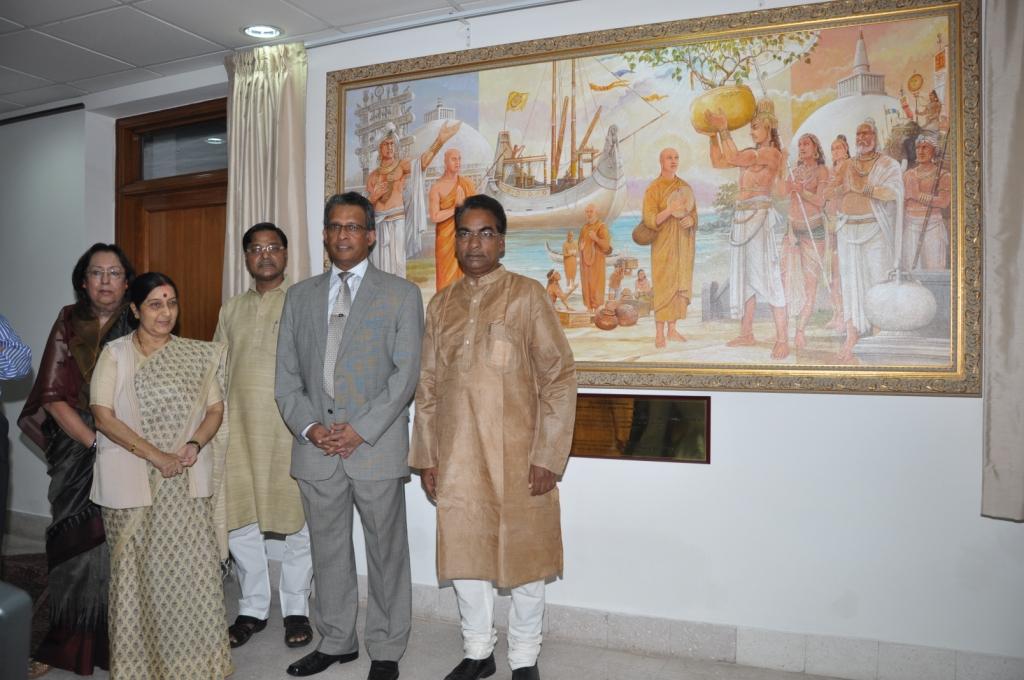
Sushma Swaraj, Leader of Opposition in the Lok Sabha and Member of Parliament from Vidisha where Sanchi is situated, unveiled a painting at the Sri Lanka High Commission in New Delhi on 1 September, in commemoration of the 2600th year of the Sambuddhatva Jayanti.
The painting depicts Emperor Asoka requesting his son Arhat Mahinda to set off to Sri Lanka from Sanchi in Vidisha with the message of Buddhism and Theri Sanghamitta and the sapling of the sacred Bodhi tree being received in Anuradhapura in Sri Lanka in the 3rd Century BC.
Welcoming the Leader of Opposition, Sushma Swaraj, several members of the Indian Parliament and a large number of distinguished invitees from India and the diplomatic community in India accredited to Sri Lanka, High Commissioner Prasad Kariyawasam stated that the event is not just an unveiling of an artist’s impression but much more than that. He elaborated that, it is a celebration of the historic civilizational ties between India and Sri Lanka that must not be confined to history. Given its profound impact on peace and prosperity to the region, this event in history must be carried forward into the future, he said. It is a story that still inspires and can continue to provide inspiration to the people of our two nations, in social, political and economic revival in the 21st century. Speaking further, he said:
-It is the celebration of the life of Emperor Asoka who forged India into a single nation-State. Whose distinctive voice of peace, non-violence and conquest by moral force and good governance echo over time. In fact several Asokan ideals and symbols continue to resonate in post-colonial resurgent India.
-It is the celebration of the strong relations between two neighbours that flourished 2300 years ago during the time of Emperor Asoka and King Devanampiyatissa of Sri Lanka – an Emperor of a strong India and the King of a much smaller country. This relationship, in its content, holds lessons that we could draw from even today, for fashioning partnerships of trust, friendship and cooperation not only between neighbours, but between all nation-States of the modern world.
-It is a celebration of the Enlightenment of Prince Siddhartha as Gautama Buddha 2600 years ago, that Great Teacher of peace and non-violence of India, who’s Message has traversed far beyond and brought solace to thousands in all corners of the world.
-Finally, it is a celebration of the vibrant and friendly relations which continue to exist between India and Sri Lanka. In fact, it is in this context that, in recognition of the shared cultural and civilisational links that provide the bedrock to our bilateral relations, H.E. President Mahinda Rajapaksa and H.E. Prime Minister Dr. Manmohan Singh agreed during President Rajapaksa’s visit to India in June 2010, that the 2600th year of the enlightenment of the Gautama Buddha will be commemorated through joint activities.
In her remarks following the ceremonial unveiling of the painting, Leader of Opposition Sushma Swaraj stated that she is honoured to participate in this event as the Member of Parliament from Vidisha where Sanchi is situated. She recalled the important cultural and buddhistic links between India and Sri Lanka and reiterated India’s commitment to the unity, sovereignty and territorial integrity of Sri Lanka. Referring to her visit to Sri Lanka earlier this year, leading a multi-party Parliamentary delegation, the Leader of Opposition stated that she was impressed by the resettlement, rehabilitation and reconstruction efforts of the Government of Sri Lanka, as well as the approaches made by all parties towards reconciliation. She expressed the hope that the reconciliation process would move swiftly ensuring peace, prosperity and a bright future for Sri Lanka.
The full text of the High Commissioner’s Statement is appended below.
High Commission of Sri Lanka in India
New Delhi
2 September 2012
Remarks by
H.E. Mr. Prasad Kariyawasam, High Commissioner for Sri Lanka to India,
at the Unveiling of the Painting at the High Commission
1 September 2012
-Hon. Sushma Swaraj, Member of Parliament from Vidisha and Leader of Opposition in the Lok Sabha,
-Excellencies,
-Honourable Members of Parliament and other distinguished guests,
-Ladies and gentlemen,
My colleagues and I welcome you most warmly to the Sri Lanka High Commission. We are honoured by your presence here. And we thank you profoundly for sparing your time to be here on a Saturday evening to share this very special occasion with us.
Let me explain what this event is all about in a brief historical narrative, on the basis of the 2500-year old recorded history of Sri Lanka, and historical evidence found in both India and in Sri Lanka.
The year beginning in May 2011 marked the 2600th year, since the enlightenment of Prince Siddhartha, as Gautama Buddha, in Bodhgaya in North India. Following his enlightenment in the 6th Century BC, the Buddha delivered his first sermon in Sarnath, near Varanasi. This event engendered an intellectual and ethical movement in India that spread along the Gangetic valley, and into several kingdoms in North India, between the Vindhya mountains and the Himalayas. At the time of the Buddha’s passing in the year 483 BC., almost all the important kingdoms or states in North India were influenced by the Teaching of Gautama Buddha. In fact, in symbolic reverence, eight kingdoms claimed a portion of the ashes of this Enlightened Teacher when he passed away.
About 200 years later, Emperor Asoka of the Maurya clan succeeded to the vast empire which had been built by his father and grandfather, under the guidance of statesmen such as Kautilya. The Mauryan Empire reached its zenith during this time. Emperor Asoka’s Rock Edicts help us gauge the borders of his Empire. Asokan inscriptions have been found in northwestern Pakistan, eastern Afghanistan, western India (Gujarat and Maharashtra), southern India (Karnataka and Andhra Pradesh) and eastern India (Orissa). This demonstrates the network of administrative control of the Asokan Empire. The inscriptions were written in various dialects of Prakrit vernaculars. Moreover, bilingual translations have been discovered in Greek and Aramaic at Kandahar in Afghanistan. These illustrate the importance he gave to spreading his messages to the borderland inhabitants of his Empire, in their own languages.
In his 13th Rock Edict, it is recorded that Emperor Asoka felt great remorse after his conquest of Kalinga (modern Orissa) around 262 BC. The Emperor’s mind which was immensely disturbed by the horrors of the Kalinga war, found solace in the teaching of the Buddha. The Asokan edicts in sites associated with the life of the Buddha such as Sarnath and Kausambi as well as Sanchi indicate that Buddhism became a chief concern of Emperor Asoka after the conquest of Kalinga. He took an active interest in the welfare of the religion, assuming its temporal leadership. The influence of Buddhism brought about a transformation not only in the Emperor’s personal life and character, but in his public policy and administration as well.
Being a wise ruler of a vast empire, consisting of different religious denominations, Emperor Asoka adopted a conscious policy to evolve a system of morality and welfare which would appeal to all his subjects of different faiths. His Rock edicts and other historical evidence stand testimony to this fact.
The 13th Rock Edict says that he “considers victory by Dhamma to be the foremost victory” and that “he wishes that all beings should be unharmed, self-controlled, calm in mind, and gentle”. He adds, that any sons or great grandsons that he may have, should not think of gaining new conquests; and that they should only consider conquest by Dhamma to be a true conquest. The Emperor went on to implore the people and ministers of his realm to live and govern according to the principles of Dhamma; which, in his view, included the ideals of non-violence, religious tolerance, respect for, parents, teachers, the elderly, women and even animals.
The Emperor, true to his new enlightened vision, would have wished to win the goodwill of his neighbouring countries, through a doctrine of peaceful co-existence that would benefit the Asokan Empire. Therefore, he embarked on a campaign of Moral Conquest or Dharma-vijaya, and sent missionaries to 9 countries. Sri Lanka was one of these countries whose King, Devanampiyatissa, he had already befriended. Perhaps as a result of this friendship, he sent his own son Arhat Mahinda, already an enlightened Buddhist monk, to Sri Lanka, with the Message of Buddhism. Soon thereafter, his daughter Sanghamitta who had become a Buddhist nun was sent to Sri Lanka with a sapling of the Pipal tree under which the Buddha attained enlightenment in Bodhgaya. This tree continues to stand in Anuradhapura even today. It is acknowledged as the oldest recorded tree in the world, and has remained in continuous worship since its inception in the 3rd Century BC.
Ancient and steeped in legend, historic relations between the people of India and Sri Lanka reached their highest point during the time of Emperor Asoka and King Devanampiyatissa of Sri Lanka. Arhat Mahinda and Theri Sanghamitta took with them to Sri Lanka, much more than the Message of Buddhism. New forms of art, architecture and cultural practices followed. And, they made a deep impression on Sri Lankan civilisation.
The painting that will be unveiled today portrays these important facts through the eyes of an artist.
Ladies and Gentlemen,
The event today however, is not just an unveiling of an artist’s impression;
-It is the celebration of the historic civilizational ties between India and Sri Lanka that must not be confined to history. Given its profound impact on peace and prosperity to the region, this event in history must be carried forward into the future. It is a story that still inspires and can continue to provide inspiration to the people of our two nations, in social, political and economic revival in the 21st century.
-It is the celebration of the life of Emperor Asoka who forged India into a single nation-State. Whose distinctive voice of peace, non-violence and conquest by moral force and good governance echo over time. In fact several Asokan ideals and symbols continue to resonate in post-colonial resurgent India.
-It is the celebration of the strong relations between two neighbours that flourished 2300 years ago during the time of Emperor Asoka and King Devanampiyatissa of Sri Lanka – an Emperor of a strong India and the King of a much smaller country. This relationship, in its content, holds lessons that we could draw from even today, for fashioning partnerships of trust, friendship and cooperation not only between neighbours, but between all nation-States of the modern world.
-It is a celebration of the Enlightenment of Prince Siddhartha as Gautama Buddha 2600 years ago, that Great Teacher of peace and non-violence of India, who’s Message has traversed far beyond and brought solace to thousands in all corners of the world.
-Finally, it is a celebration of the vibrant and friendly relations which continue to exist between India and Sri Lanka. In fact, it is in this context that, in recognition of the shared cultural and civilisational links that provide the bedrock to our bilateral relations, H.E. President Mahinda Rajapaksa and H.E. Prime Minister Dr. Manmohan Singh agreed during President Rajapaksa’s visit to India in June 2010, that the 2600th year of the enlightenment of the Gautama Buddha will be commemorated through joint activities.
Madam Sushma Swaraj,
For us in Sri Lanka, you are a very special lady. Your Parliamentary constituency, Vidisha, where Sanchi is located, was home to Emperor Asoka’s children Arhat Mahinda and Theri Sanghamitta, thousands of years ago. The Buddha’s Teaching, as we know, was based on equality among humans and was open to men and women equally. In Asokan India, it was a woman, Theri Sanghamitta, who was chosen to carry the sapling of the ‘tree of wisdom’ to Sri Lanka. We consider her as the first lady Ambassador to our country on an important Mission, and she is revered continuously through history even to this day, in my country.
It was another Lady, Princess Hemamala from ancient Kalinga who bequeathed the sacred tooth-relic of the Buddha to Sri Lanka in the year 371 AC.
Madam, we in Sri Lanka see you in similar light, as a modern-day Leader and an envoy of India promoting regional cooperation and peace. You toil with wisdom, to forge closer relations between the people of our two countries, following a long list of distinguished and inspirational ladies from our past. It is therefore an honour for us to have you unveil this painting which holds a deep, significant meaning for us, and in our view, for our two countries. It is an honour for us to have your name placed in this Mission in a lasting form as the Member of Parliament from Vidisha, a region with which we have a celebrated historical bond.
Madam, may I now invite you to unveil the painting and address us thereafter.
Thank you.
Please follow and like us:




